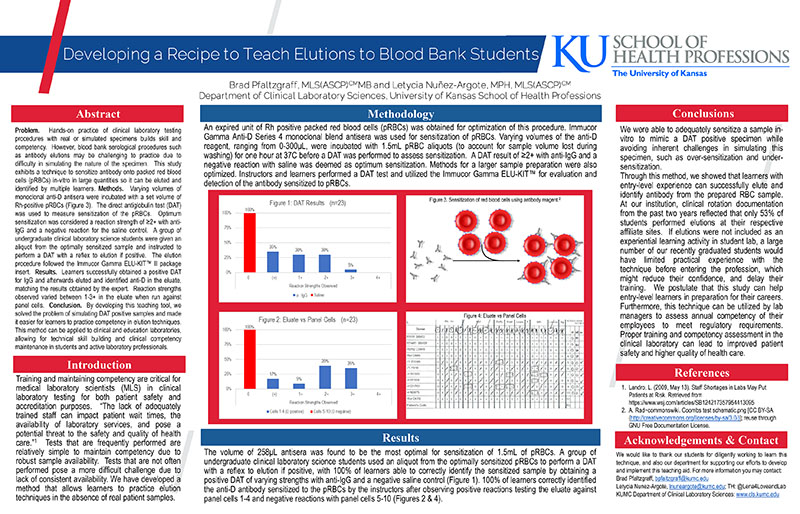
Hover to pan and click to magnify. Click again to pan at full screen.
Brad Pfaltzgraff, MLS(ASCP)CM and Letycia Nuñez-Argote, MPH, MLS(ASCP)CM
Brad Pfaltzgraff, MLS(ASCP)CM and Letycia Nuñez-Argote, MPH, MLS(ASCP)CM
KU School of Health Professions
Abstract
Problem. Hands-on practice of clinical laboratory testing procedures with real or simulated specimens builds skill and competency. However, blood bank serological procedures such as antibody elutions may be challenging to practice due to difficulty in simulating the nature of the specimen. This study exhibits a technique to sensitize antibody onto packed red blood cells (pRBCs) in-vitro in large quantities so it can be eluted and identified by multiple learners. Methods. Varying volumes of monoclonal anti-D antisera were incubated with a set volume of Rh-positive pRBCs (Figure 3). The direct antiglobulin test (DAT) was used to measure sensitization of the pRBCs. Optimum sensitization was considered a reaction strength of ≥2+ with anti-IgG and a negative reaction for the saline control. A group of undergraduate clinical laboratory science students were given an aliquot from the optimally sensitized sample and instructed to perform a DAT with a reflex to elution if positive. The elution procedure followed the Immucor Gamma ELU-KIT™ II package insert. Results. Learners successfully obtained a positive DAT for IgG and afterwards eluted and identified anti-D in the eluate, matching the results obtained by the expert. Reaction strengths observed varied between 1-3+ in the eluate when run against panel cells. Conclusion. By developing this teaching tool, we solved the problem of simulating DAT positive samples and made it easier for learners to practice competency in elution techniques. This method can be applied to clinical and education laboratories, allowing for technical skill building and clinical competency maintenance in students and active laboratory professionals.
Introduction
Training and maintaining competency are critical for medical laboratory scientists (MLS) in clinical laboratory testing for both patient safety and accreditation purposes. “The lack of adequately trained staff can impact patient wait times, the availability of laboratory services, and pose a potential threat to the safety and quality of health care.”1 Tests that are frequently performed are relatively simple to maintain competency due to robust sample availability. Tests that are not often performed pose a more difficult challenge due to lack of consistent availability. We have developed a method that allows learners to practice elution techniques in the absence of real patient samples.
Methodology
An expired unit of Rh positive packed red blood cells (pRBCs) was obtained for optimization of this procedure. Immucor Gamma Anti-D Series 4 monoclonal blend antisera was used for sensitization of pRBCs. Varying volumes of the anti-D reagent, ranging from 0-300μL, were incubated with 1.5mL pRBC aliquots (to account for sample volume lost during washing) for one hour at 37C before a DAT was performed to assess sensitization. A DAT result of ≥2+ with anti-IgG and a negative reaction with saline was deemed as optimum sensitization. Methods for a larger sample preparation were also optimized. Instructors and learners performed a DAT test and utilized the Immucor Gamma ELU-KIT™ for evaluation and detection of the antibody sensitized to pRBCs.
(View poster)
Results
The volume of 258μL antisera was found to be the most optimal for sensitization of 1.5mL of pRBCs. A group of undergraduate clinical laboratory science students used an aliquot from the optimally sensitized pRBCs to perform a DAT with a reflex to elution if positive, with 100% of learners able to correctly identify the sensitized sample by obtaining a positive DAT of varying strengths with anti-IgG and a negative saline control (Figure 1). 100% of learners correctly identified the anti-D antibody sensitized to the pRBCs by the instructors after observing positive reactions testing the eluate against panel cells 1-4 and negative reactions with panel cells 5-10 (Figures 2 & 4).
Conclusions
We were able to adequately sensitize a sample in-vitro to mimic a DAT positive specimen while avoiding inherent challenges in simulating this specimen, such as over-sensitization and under-sensitization.
Through this method, we showed that learners with entry-level experience can successfully elute and identify antibody from the prepared RBC sample. At our institution, clinical rotation documentation from the past two years reflected that only 53% of students performed elutions at their respective affiliate sites. If elutions were not included as an experiential learning activity in student lab, a large number of our recently graduated students would have limited practical experience with the technique before entering the profession, which might reduce their confidence, and delay their training. We postulate that this study can help entry-level learners in preparation for their careers. Furthermore, this technique can be utilized by lab managers to assess annual competency of their employees to meet regulatory requirements. Proper training and competency assessment in the clinical laboratory can lead to improved patient safety and higher quality of health care.
References
1. Landro, L. (2009, May 13). Staff Shortages in Labs May Put Patients at Risk. Retrieved from https://www.wsj.com/articles/SB124217357954413095
2. A. Rad~commonswiki. Coombs test schematic.png [CC BY-SA (http://creativecommons.org/licenses/by-sa/3.0/)]; reuse through GNU Free Documentation License.
Acknowledgements & Contact
We would like to thank our students for diligently working to learn this technique, and also our department for supporting our efforts to develop and implement this teaching aid. For more information you may contact: Brad Pfaltzgraff, bpfaltzgraff@kumc.edu Letycia Nunez-Argote, lnuneargote@kumc.edu; TH: @Lena4LoveandLab KUMC Department of Clinical Laboratory Sciences: www.cls.kumc.edu

Present with Google Meet
Invite as many as 30 people, and present your poster in high definition. Transcription option is available. Free to use.
DISQUS COMMENTS WILL BE SHOWN ONLY WHEN YOUR SITE IS ONLINE